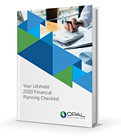Smart Money Moves for Women in 2023
By Katherine M. Dean, CFP® | January 4, 2023It can sometimes feel like the financial deck is stacked against women. We earn 82 cents for every dollar a man makes, according to a recent PayScale report. A woman’s income and ability to save for retirement may also be impacted by caregiving roles. The CDC reports that two out of every three caregivers in the U.S. are women. Meanwhile, women are expected to live longer, which means we’ll likely need more money in retirement. On a positive note, a record number of women are investing outside of retirement—and outperforming male investors by 40 basis points, according to a 2021 Fidelity Investments analysis.

I’m a financial advisor who’s dedicated to leveling the playing field and helping women overcome financial adversity. With a new year ahead, now is the perfect time for women to review their finances. Doing so can reduce financial stress, increase well-being, and set the stage for long-term financial strength. Here are five simple action items to help you get there.
Review Cash Flow
Now is an ideal time to review your cash flow. After meeting all your monthly financial obligations, how much is left over for saving and investing? Eliminating unnecessary expenses can free up more cash to put toward your financial goals. Begin by tracking your spending from the last few months. You can do this easily with an app or by reviewing your recent credit card and debit card statements. The idea is to clarify your spending habits.
Your income is just as important. When you research average compensation in your area for your position and experience, how does your current pay measure up? If there’s a gap, it may be time to negotiate a pay raise or look for a new employer. If you don’t advocate for yourself, no one else will.
Increase Your Emergency Fund
It’s only a matter of time before you run into a surprise expense. That might be a small-scale hiccup like a minor home repair or medical bill—or something more substantial. An unexpected job loss could turn your finances upside down if you aren’t prepared.
The rule of thumb is to have three to six months’ worth of expenses in your emergency fund, but you might go higher if your income fluctuates. This money should ideally be held in a high-yield savings account that’s easy to access should you need it. If your emergency fund is tied up in your 401(k), for example, you’ll pay taxes on any distributions—plus a 10% early withdrawal penalty if you’re under 59 ½. You’re also depleting your nest egg. To increase your emergency fund, funnel a portion of every paycheck into your savings account. You can also use your next tax refund to strengthen your savings.
Bump Up Your Investing Dollars
If you’re already investing in a 401(k) or other retirement account, that’s great! Take a step further and see if you can dial that up a bit. An ideal target is 15% of your income, but saving even 5% to 10% can have a huge impact over time. Try to contribute at least enough to secure an employer match. Most programs will match up to 3% of your salary, and some will go even higher. Self-employed? Consider a solo 401(k), SEP IRA, or traditional or Roth IRA. They can help female entrepreneurs save for their future in a tax-efficient way.
Retirement accounts aside, you can also invest through a regular brokerage account. Assets may include:
- Stocks
- Bonds
- Mutual funds
- Exchange-traded funds (ETFs)
- Money market accounts
- Certificates of deposit (CDs)
- Hedge funds
- Real estate investment trusts (REITs)
The goal is to create a well-diversified investment portfolio that’s built around your risk tolerance, financial goals, and retirement time horizon. That’s really important for those women who are currently under-invested or holding the bulk of their wealth in cash.
Review Your Health Care Spending
If you aren’t happy with your current health insurance plan, you can change it if you’re within your open enrollment window. During this time, you can enroll in new coverage without having to experience a qualifying life event (such as getting married or divorced). The open enrollment period for plans purchased through Healthcare.gov ends on January 15, 2023. If you have an employer-sponsored health plan and can’t make changes at this time, a health savings account (HSA) may be worth considering.
An HSA is a tax-advantaged account for people with a high-deductible health plan. In 2023, that’s a plan with a minimum deductible of $1,500 for individuals ($3,000 for families). Money in an HSA can be used to pay for qualified medical expenses. That includes deductibles, copays, prescription drugs and more. HSAs can be structured as investment accounts—and they have some pretty nice tax perks. Contributions are tax-deductible, earnings grow tax-free, and you won’t be taxed on withdrawals that are used for qualified medical expenses.
Take Stock of Your Financial Goals
The beginning of the year is a great time to reevaluate your financial goals. On top of building your emergency fund and investing more, you might also be hoping to buy a home, save for your kids’ college education, or pay down debt. Think about what matters to you most and what progress you’d like to make by the end of the year. The right financial advisor can help identify what steps you’ll need to take to get there. The OpalWomen process is simple. We aim to:
- Clarify your goals
- Create a road map toward financial freedom
- Guide you through each step of the journey
If this resonates with you, I’d love to help you make your vision a reality. Schedule a discovery call with me today to get started.
Be a Smart Investor
Stay up-to-date with industry-leading information and news delivered straight to your inbox.
Get our timely insights delivered to your inbox (Blog)
Please remember that past performance may not be indicative of future results. Different types of investments involve varying degrees of risk, and there can be no assurance that the future performance of any specific investment, investment strategy, or product (including the investments and/or investment strategies recommended or undertaken by Opal Wealth Advisors, LLC [“OWA]), or any non-investment related content, made reference to directly or indirectly in this commentary will be profitable, equal any corresponding indicated historical performance level(s), be suitable for your portfolio or individual situation, or prove successful. Due to various factors, including changing market conditions and/or applicable laws, the content may no longer be reflective of current opinions or positions. Moreover, you should not assume that any discussion or information contained in this commentary serves as the receipt of, or as a substitute for, personalized investment advice from OWA. OWA is neither a law firm, nor a certified public accounting firm, and no portion of the commentary content should be construed as legal or accounting advice. A copy of the OWA’s current written disclosure Brochure discussing our advisory services and fees continues to remain available upon request or at www.opalwealthadvisors.com. Please Remember: If you are a OWA client, please contact OWA, in writing, if there are any changes in your personal/financial situation or investment objectives for the purpose of reviewing/evaluating/revising our previous recommendations and/or services, or if you would like to impose, add, or to modify any reasonable restrictions to our investment advisory services. Unless, and until, you notify us, in writing, to the contrary, we shall continue to provide services as we do currently. Please Also Remember to advise us if you have not been receiving account statements (at least quarterly) from the account custodian.



